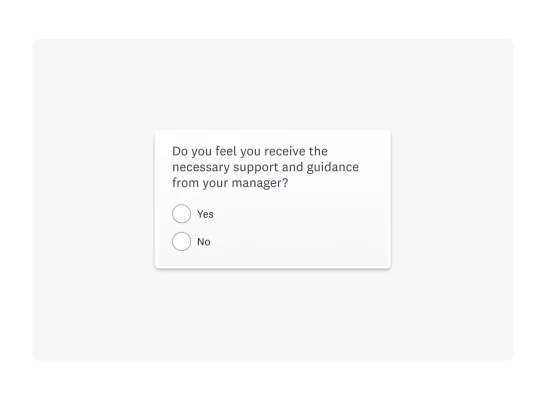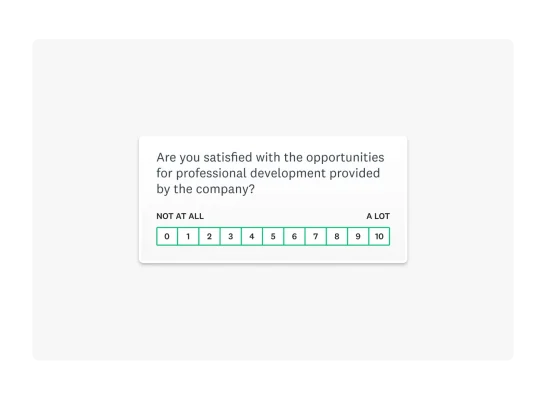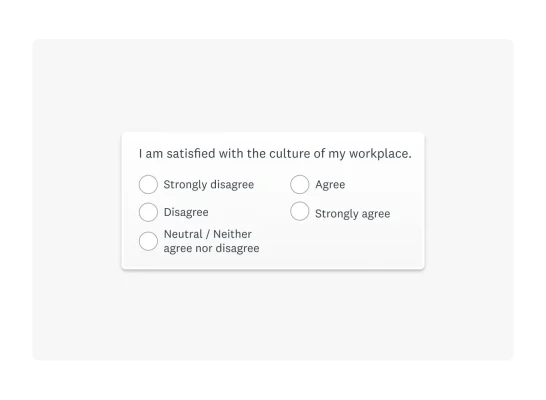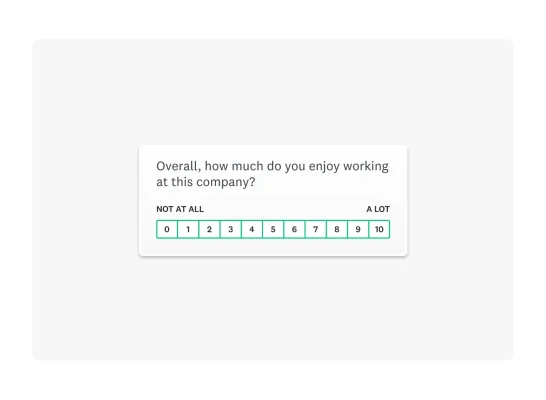Employee engagement surveys: Questions, examples, and a simple plan to act on results
Use employee engagement surveys to increase morale, retention, and productivity.

Engaged employees make organizations thrive. They’re more productive, stay longer, and drive stronger business outcomes—proof that engagement isn’t just a feeling, it’s a growth strategy.
Most of us have seen that familiar email asking us to complete the annual employee engagement survey. Too often, it feels like a formality—especially when nothing changes afterward. That gap between asking and acting is where many organizations lose momentum.
Gallup research found that global employee engagement declined in 2024 for the first time since 2020, with managers showing the sharpest drop. Yet, teams with strong engagement consistently outperform in productivity, profitability, and retention. Harvard Business Review calls this the “ask, then act” gap—where feedback sits in dashboards instead of fueling change.
This guide helps you close that gap. Inside, you’ll find 50+ SurveyMonkey-recommended employee engagement survey questions, expert tips for running trusted surveys, guidance on analyzing results, and a 30-day playbook to turn insights into measurable action.
What is employee engagement?
Employee engagement is the degree to which people feel valued, involved, and motivated in their everyday work. It reflects whether employees feel connected to your company’s mission, trusted by leadership, and empowered to contribute to shared success.
Why is employee engagement important?
Employee engagement is important because it directly influences morale, satisfaction, retention, and the overall health of your culture. When people are engaged, they’re more motivated, more connected to their work, and more likely to stay—driving better performance across teams and the organization.
Employee engagement surveys make that impact measurable. They give employees a safe, structured way to voice concerns, ideas, and questions, then turn that feedback into a data-driven action plan. Run on a regular cadence, these surveys signal that every voice matters, surface emerging issues early, help you recognize high performers, and close the feedback loop—building trust and contributing to a more positive, transparent workplace.
What is an employee engagement survey?
An employee engagement survey is a structured assessment that evaluates how motivated, committed, and aligned employees are with their work, team, and organization. It translates the feelings and experiences behind engagement, such as trust in leadership, recognition, and growth, into measurable data you can act on to strengthen culture and performance.
When engagement drops, it’s an early signal that your culture needs attention. Regularly measuring it helps you spot burnout, turnover risk, and communication gaps before they grow. In other words, an employee engagement survey is your organization’s health check—and the first step toward a more connected, committed workforce.
Get real results with our expert-certified Employee Engagement Survey Template
Use our survey template to increase employee morale, retention, and workplace productivity.
50+ example survey questions to benchmark employee engagement
To see engagement clearly, you need the right questions, the kind that turn feelings into data and data into action. The following sample employee engagement questions turn abstract ideas into measurable signals you can track over time that are clear enough for a quick response, but precise enough to guide action. Use them to establish a baseline, spot patterns, and focus effort where it will have the greatest impact.
These agree/disagree questions represent 6 key dimensions that shape how people experience work—from leadership clarity to wellbeing support. Each one helps reveal a piece of the engagement puzzle: what motivates, what connects, and where opportunities to improve may be hiding.
Leadership and vision

Engagement starts at the top. When employees believe in the company’s direction—and trust the people guiding the company’s direction—they’re far more likely to bring their full energy to work.
- I understand the company’s long-term goals.
- I feel motivated by the company’s vision and goals.
- The leadership team demonstrates a clear understanding of the company’s goals.
- I believe senior leaders communicate openly and honestly.
- The leadership team communicates the company’s vision effectively.
- The leadership team provides adequate support to achieve the company’s goals.
- The leadership team values employee input and feedback.
- Leadership demonstrates that people are important to the company’s success.
- I trust decisions made by senior management.
- I feel that the leadership team is approachable and easy to talk to.
Career growth

Nobody wants to feel stuck. Opportunities for employees to learn and grow show that the organization values its people and invests in their success through a thoughtful employee engagement program.
- I am satisfied with the career growth opportunities available to me at this company.
- I have a clear understanding of the career paths available to me within the company.
- I feel that I have the necessary resources and support to achieve my goals.
- I believe that there are adequate opportunities for professional development and training.
- I am aware of the criteria for promotions and career advancements within the company.
- I feel that my contributions are recognized and valued by the company.
- I am confident in my ability to achieve my career goals within this company.
- I believe that the company provides fair and equal opportunities for career growth to all employees.
- I feel that the company is committed to helping employees develop their careers.
- I am satisfied with the feedback and guidance I receive regarding my career development.
Culture and values

A strong culture isn’t built on quirky slogans. It grows from shared values that guide everyday decisions. When those values align with personal purpose, engagement develops naturally.
- I feel valued and appreciated for the work I do.
- The company’s culture encourages collaboration and teamwork.
- I believe in the company’s mission and values.
- The leadership team communicates effectively with employees.
- The company fosters an inclusive and diverse environment.
- The company’s values align with my own.
Teamwork and communication
Strong collaboration is a reliable driver of engagement. Open communication and collaboration help ideas flow, solve problems faster, and make work feel more human.
- I feel that my team works well together.
- Team members are willing to help each other when needed.
- I feel comfortable sharing my ideas and opinions with my team.
- Communication within my team is effective.
- My manager provides clear directions and feedback.
- I feel that my contributions to the team are valued.
- There is a good balance of communication and work within my team.
- I am satisfied with the level of collaboration in my team.
- Team meetings are productive and well-organized.
- There is open and honest communication within my team.
Job satisfaction

Overall job satisfaction is closely connected to employee engagement. The right survey questions help you understand whether people feel fulfilled in their roles and motivated to contribute to the organization’s success. Below are practical examples you can use to measure satisfaction and identify areas for improvement.
- I feel valued as an employee at this company.
- I am satisfied with the level of communication within the company.
- I have the resources I need to do my job well.
- I feel that my work is recognized and appreciated.
- I am satisfied with my opportunities for professional growth.
- I am satisfied with the company’s efforts to promote diversity and conclusion.
- I would recommend this company as a great place to work.
Work-life balance and wellbeing
True engagement isn’t about pushing harder until burnout. It’s about creating balance that sustains energy, where people feel supported to grow, contribute, and thrive at work and in life.
- I feel that I have a good balance between my work and personal life.
- My workload is manageable within my regular working hours.
- I am able to take breaks when needed during my workday.
- I feel supported by my manager in achieving a healthy work-life balance.
- The company provides sufficient resources to support employee wellbeing.
- I feel that my mental health is a priority at work.
- I feel that my mental health is a priority at work.
- I am satisfied with the work-life balance policies provided by the company.
- I feel that my physical health is a priority.
- I am able to disconnect from work during my personal time.
- I feel that my overall wellbeing is valued by the company.
Engagement vs. satisfaction (quick comparison)
Employee engagement and employee satisfaction are often used interchangeably, but they drive different outcomes. Employee satisfaction shows if people like their jobs and can be used to understand how employees feel about their day-to-day activities. On the other hand, employee engagement shows if those same employees will stay and thrive.
Engagement surveys can help you prioritize organization-wide changes with greater impact. In other words, engagement is the energy that powers performance; satisfaction keeps the workplace running smoothly.
| Employee engagement | Employee satisfaction | |
| What it drives | Emotional commitment to the organization’s goals | Contentment with job conditions |
| What it measures | Purpose, recognition, leadership, growth | Pay, workload, benefits |
| What are the outcomes | Improvements in motivation, performance, advocacy | Short-term morale |
| Example question | “I know how my work contributes to company goals.” | “I’m satisfied with my compensation.” |
The four levels of employee engagement
There are four distinct levels of employee engagement, each serving as a benchmark you can use to measure culture, track progress, and guide future employee engagement surveys. Most employees fall into one of four engagement levels, offering a powerful benchmark for understanding team morale, motivation, and culture.
1. Highly engaged employees
These employees are energized, committed, and inspired by their work. They act as brand advocates, share ideas freely, and go beyond their job descriptions to help the company succeed. They believe in the organization’s goals and see their role as key to achieving them.
2. Moderately engaged employees
Moderately engaged employees are reliable contributors who generally feel positive about their work. They perform well but may lack consistent enthusiasm or a clear sense of how their efforts tie to the bigger picture. With coaching or clearer communication, they have strong potential to grow into top performers.
3. Minimally engaged employees
These employees meet expectations but rarely exceed them. They tend to view their work as a transaction rather than a source of meaning or growth. While not overtly negative, they’re often disengaged from the company’s purpose and may be exploring other opportunities.
4. Disengaged employees
Disengaged employees are dissatisfied and disconnected. They may resist change, withdraw from collaboration, or spread negativity that impacts team morale. Identifying this group early through engagement surveys is essential to rebuilding trust and reestablishing connection.
What engagement levels reveal about your culture
Tracking these engagement levels over time helps you measure cultural health and leadership effectiveness. By using employee engagement surveys as recurring benchmarks, organizations can spot emerging risks, uncover areas of strength, and focus on the changes that matter most.
Understanding where your workforce stands today is the first step toward building a culture where everyone feels motivated to contribute and proud to stay.
Types of engagement surveys (and when to use them)
Choosing the right survey type is about matching your goals to what teams actually need. Each approach offers a way to match the survey to your goal. Do you need a strategy readout or quick post-change pulse? When you understand the question you want to answer, you can choose the best survey type to fit your goals
| Survey type | Cadence | Insight gained |
| Annual/biannual | Once or twice yearly | Set a comprehensive baseline for strategy and benchmarking |
| Pulse surveys | Monthly or quarterly | Quick read on sentiment, especially after new initiatives or changes |
| Lifecycle surveys | Key milestones (onboarding, promotion, company exit) | Capture insights around key employee moments |
| Remote or hybrid surveys | As needed | Spot inclusion or collaboration gaps in flexible work environments |
| Culture or benefits pulses | After policy changes | Understand satisfaction on specific topics like wellbeing or flexibility |
Each format has its benefits: annual surveys offer big-picture insight, while more frequent pulse surveys maintain a steady read on organizational sentiment. Using the right SurveyMonkey template lets you tailor timing and content, so every survey feels relevant.
How to conduct an employee engagement survey
Running a trusted employee survey begins with purpose. Every decision, from communicating your goals to safeguarding privacy, reinforces that every voice matters. When you make the process clear, secure, and inclusive, employees feel confident sharing honest feedback that drives real improvement.
Here’s a quick launch checklist to help you start strong and keep the process smooth for everyone
- Define your survey’s purpose.
- Survey a diverse, representative group.
- Promise privacy and stand by it.
- Communicate the survey’s goals and how results will be used.
- Make sure your survey is easy to use on any device—and in any language.
- Pilot the survey to catch confusing questions.
- Confirm you’re following data privacy rules everywhere.
- Plan your launch and next steps.
This might seem like a lot to manage, but with adaptable templates, smart logic, and device compatibility, SurveyMonkey makes it easier for you to turn feedback into meaningful results. When you start your employee engagement program with a solid plan, you develop a reliable way to hear every voice in your organization and make decisions that drive impact, not just changes.
How to analyze employee engagement survey results
The best employee engagement metrics make patterns clear. They show how people feel, where they’re thriving, and where support is missing.
Although surveys generate plenty of data, a few focused metrics reveal the story that matters most. High response rates signal trust in the process and a willingness to share. Percent favorability and average scores highlight the parts of your culture that work well and the areas that need more attention.
When certain results dip or open-text feedback points to recurring issues, it’s a cue to explore further and act quickly. With the right analysis, your engagement survey moves beyond a snapshot of sentiment and turns into a clear roadmap for improvement.
Here’s how to spot what matters most:
- Track response rate (aim for 70%+)—engaged teams participate.
- Use percent favorability (“agree” or “strongly agree”) for clarity on strengths and pain points.
- Compare heatmaps across teams, departments, or locations to find unexpected bright spots or problem areas.
- Calculating employee Net Promoter Score gives a quick pulse on advocacy—are employees promoters, passives, or detractors?
- Review comments to uncover stories or recommendations that metrics alone might hide.
- Develop an action plan for categories under 60% favorability.
For example:
| Item | Favorability | Flag |
| “My manager communicates effectively.” | 58% | 🔴 Action needed |
| “I understand company goals.” | 85% | 🟢 Maintain |
A simple red-yellow-green rubric turns complex data into a crystal-clear action map. SurveyMonkey Analyze makes understanding your data easy. You can filter results by role, tenure, or team—all backed up by robust export options for deeper dives. By focusing on actionable patterns instead of overwhelming complexity, your engagement surveys move the organization forward, closing one feedback loop at a time.
Employee engagement results that inspire action: 30-day playbook
Turning survey findings into progress is the heartbeat of lasting employee engagement. The most effective teams turn insights into action quickly, showing your employees that honest feedback doesn’t go unnoticed.
- Week 1: Kick things off by sharing topline results and thanking employees for their openness. Pick one to three priority areas for focus and assign clear owners, so teams know who’s leading the charge.
- Week 2: Managers gather their teams for discussion sessions. These aren’t just for venting—collect fresh ideas for quick wins and make note of persistent blockers. Listening is continuous, not one-and-done.
- Week 3: Draft an action plan, complete with success metrics, owners, and clear deadlines. Before finalizing, check those plans with employees to ensure the next steps accurately reflect what’s needed on the ground.
- Week 4: Communicate the new action plan widely, set dates for pulse follow-ups, and announce when progress updates will roll out. This builds a company-wide cycle of trust and accountability.
Feedback is only valuable when it fuels action. Gallup’s research is clear: organizations that close the loop and act quickly on engagement data see up to 23% higher profitability. Once you’ve completed your 30-day action plan, use SurveyMonkey pulse surveys for regular check-ins and continuous improvement.
Survey mistakes that derail engagement
Even the most well-intentioned engagement surveys can trip over a few classic obstacles. Keep your strategy sharp by watching out for these frequent missteps:
| Pitfall | Result | Quick Fix |
| Too many questions | Fewer responses than expected | Stick to 25 or fewer; use pulse surveys for additional questions |
| Vague responses | Results are unclear | Use answer options that paint a clear picture (Likert scale) |
| No promise of anonymity | Fewer responses than expected | Communicate privacy protections up front |
| Delayed communication of results | Employee assumes survey didn’t matter | Share findings within two weeks of survey ending |
| No ownership of next steps | No clear plan to address employee concerns | Assign an action owner for every focus area |
| Ignoring manager enablement | Managers are uncomfortable communicating survey results | Equip managers with guides and training |
The business impact of employee engagement
Employee engagement surveys go far beyond a simple check-in; they act as a powerful catalyst for measurable business results. When organizations listen to feedback and act on it, engagement becomes a competitive advantage that drives performance, retention, and growth.
Research on high-performing workplaces shows that companies with strong employee engagement report significantly higher profitability and productivity, along with lower absenteeism and stronger customer loyalty. The data make the case clear:
- 23% higher profitability
- 78% lower absenteeism
- 14% higher productivity
- 18% higher sales performance
- 10% higher customer loyalty
Engagement is more than a metric. It’s the engine behind innovation, trust, and lasting performance. By building a culture where employees feel heard and valued, businesses create the conditions for sustainable success—one survey, one action, and one improvement at a time.
Transform employee engagement results into measurable change with SurveyMonkey
Engagement surveys aren’t just another task. They’re a powerful tool to listen, learn, and lead. When employees see their voices drive real change, engagement becomes a shared journey—and that’s where team culture and performance thrive.
To get started with a solid baseline, use the SurveyMonkey Employee Engagement Survey Template. From there, you can use pulse surveys to keep the conversation alive and the data actionable. For larger or distributed teams, explore enterprise rollouts and advanced analytics with our expert team to scale impact.
Ready to get started?
NPS, Net Promoter & Net Promoter Score are registered trademarks of Satmetrix Systems, Inc., Bain & Company and Fred Reichheld.
Discover more resources

Attract, engage, and retain top talent with data-driven insights
Create powerful HR surveys with SurveyMonkey to gather feedback, boost engagement, and improve workplace culture. Streamline HR processes with customizable templates.

Why are surveys important in research?
Surveys are important in research because they offer a flexible and dependable method of gathering crucial data. Learn more today.

Job application surveys
Survey job applicants online to get a good understanding of your recruitment process strengths and weaknesses. Free templates and survey advice, sign up today!

HR Survey Questions: 80 Examples & Best Practices
Discover 80 HR survey questions, best practices, and tips for success to improve employee engagement.